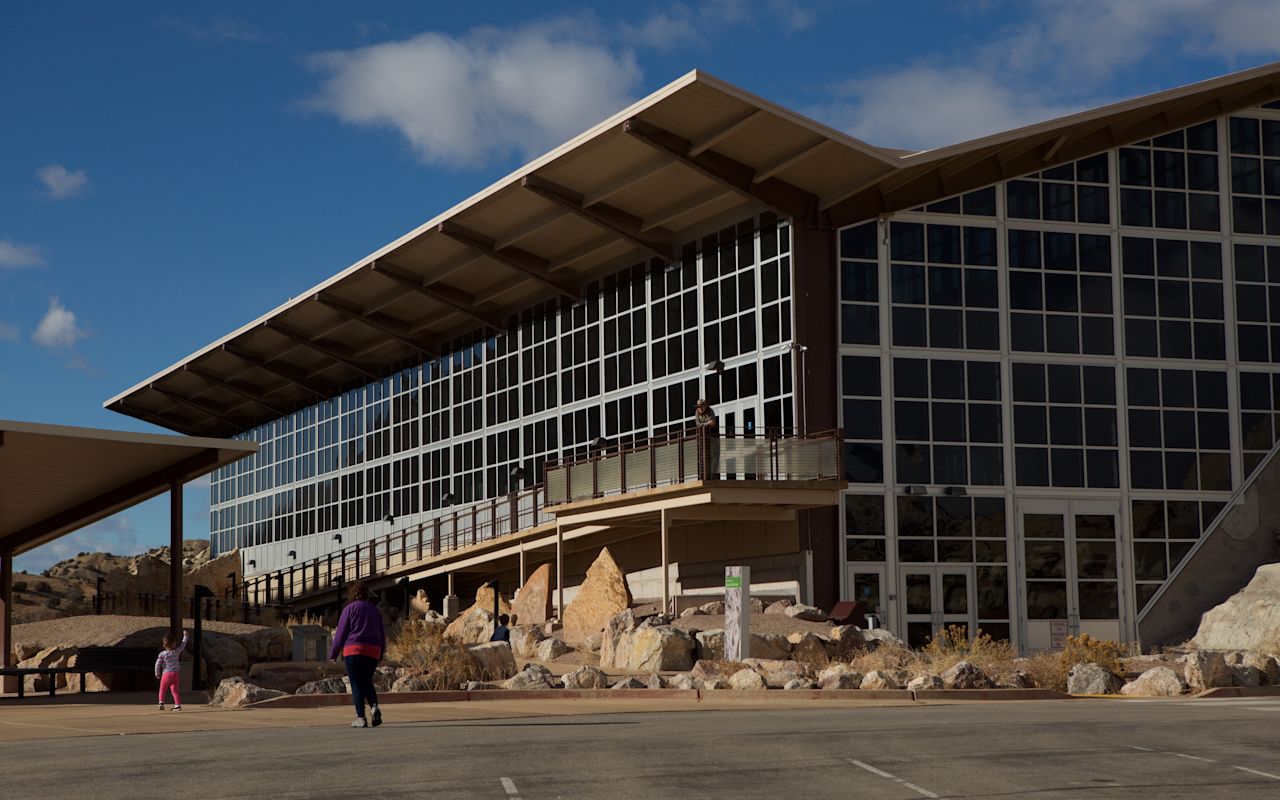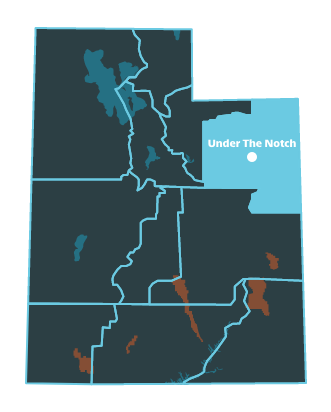Dinosaur National Monument
One of the world’s best windows into the late Jurassic Period.
In 1909, paleontologist Earl Douglass was searching for fossils for the Carnegie Museum when he discovered a formation layered with prehistoric plant and animal fossils. A quarry was established and in 1915 Dinosaur National Monument was created to protect 80 acres in the quarry area. Today the monument includes 210,844 acres.
Read more…
Promotional Links
Dinosaurland Details
Many fossils are embedded in a sloping rock formation that was once a sandbar on the edge of a large river. As the river carried animal carcasses downstream, many became stuck on the sandbar, which eventually turned to rock. As a result, fossils from hundreds of creatures are concentrated in a small area. Many fossilized bones have been partially exposed but left intact in the rock where they can be easily seen. A building was constructed over the area, which is now known as "The Quarry" at the monument.
Research is ongoing. In Feb 2010, a team of paleontologists from Dinosaur National Monument, Brigham Young University, and the University of Michigan announced the discovery of a new, large, plant-eating dinosaur, Abydosaurus McIntosh.
The Quarry area makes up only a small part of the land included within the national monument. The remaining area includes canyons cut by the Green and Yampa rivers. The park backcountry is incredibly rugged and remote. It is very scenic and some areas have high wilderness value.
Driving Directions
From Salt Lake City to Vernal, UT is approximately 173 miles.
Take I-15 S toward Las Vegas/Cheyenne. Merge onto I-80 E exit 304 toward Cheyenne. Take the US-40 E (exit 146) toward Heber/Vernal. US-40/US-191 continue to Vernal.
Visitor Center Hours and Holiday Closures
The Quarry Visitor Center is open year-round with the exception of Thanksgiving Day, Christmas Day, and New Years Day. Standard Hours, effective daily in Spring and Fall, are 9:00 a.m. to 5:00 p.m. These hours change seasonally in Summer and Winter (see the seasonal exceptions below for specific dates).
Summer Hours (May 21 - September 17)
Daily 8:00 AM - 6:00 PM
Winter Hours (December 1 - February 28)
Daily 10:00 AM - 4:00 PM
The Quarry Exhibit Hall is also open year-round with the exception of Thanksgiving Day, Christmas Day, and New Years Day. Standard Hours, effective daily in Spring and Fall, are 9:00 a.m. to 5:00 p.m. These hours change seasonally in Summer and Winter.
Summer Hours (May 21 - September 17)
Daily 8:00 AM - 5:30 PM
Winter Hours (December 1 - February 28)
Daily 10:00 AM - 4:00 PM
Holidays for both the Visitor Center and Exhibit Hall
2024–2025
New Year's Day | January 1, 2025 | Closed |
Birthday of Martin Luther King, Jr. | January 20, 2025 | 10:00 AM–4:00 PM |
Washington's Birthday | February 17, 2025 | 10:00 AM–4:00 PM |
Memorial Day | May 27, 2024 | 8:00 AM–6:00 PM |
Juneteenth National Independence Day | June 19, 2024 | 8:00 AM–6:00 PM |
Independence Day | July 4, 2024 | 8:00 AM–6:00 PM |
Labor Day | September 2, 2024 | 8:00 AM–6:00 PM |
Columbus Day | October 14, 2024 | 9:00 AM–5:00 PM |
Veterans Day | November 11, 2024 | 9:00 AM–5:00 PM |
Thanksgiving Day | November 28, 2024 | Closed |
Christmas Day | December 25, 2024 | Closed |
Dinosaur National Monument | Photo Gallery

Quarry entrance.
Places to Stay in Vernal
REQUEST INFORMATION
TRAVEL BUREAU INFORMATION
UINTAH COUNTY TRAVEL REGION
152 E. 100 N.
Vernal, UT 84078
800-477-5558
Location
Get DirectionsThings to Do Near Dinosaur National Monument
River Rafting
The Green and Yampa rivers provide an outstanding opportunity for whitewater adventure. Lodore Canyon on the Green contains multiple challenging Class III and Class IV rapids, including classics like Disaster Falls, Hell's Half Mile, and Triplet Falls. The Gates Of Lodore sports many Class III rapids and one Class IV is known as Warm Springs Rapid, which has a hydraulic named Maytag that has the tendency to flip boats. See the Guides and Outfitters section for a list of certified guides.
Learn About Geology
The unique rock formations in this area provide a geologic record of earth history covering billions of years. Part of the mission of the monument is to work to understand that history... how rocks formed over time and were shaped by rivers and other environmental factors... how plant and animal life developed and changed over time.
The monument's rocks, fossils and rivers tell an important story and provide a great opportunity for recreation.
Hiking
If you love to hike, Dinosaurland and surrounding areas offer many trails for all ability levels. Link to this page to read about our favorite Dinosaurland Hiking Trails.
Image Credit: "Moonshine Arch" by Bernd Thaller is licensed under CC BY 2.0
Visit a State Park - or Two
If you're in the mood to recreate, two state parks are located near Dinosaurland, Steinaker State Park and Red Fleet State Park. Both parks offer camping, fishing, boating, and more.
Steinaker State Park is located seven miles north of Vernal. You can fish for rainbow trout here year round, and if you're lucky, in the summer you might catch a largemouth bass, too. Steinaker is also a good spot to camp, offering campsites and two cabins for rent. Read more about Steinaker State Park here.
Red Fleet State Park is 13 miles north of Vernal. This is a great spot to fish, boat, and camp. However, Red Fleet State Park is undergoing extensive renovations, with a goal of re-opening in 2024. You can check for updates on the Red Fleet State Park website.
Explore the Town of Vernal
Image Credit: "Vernal, UT" by James Michael Thomas is licensed under CC by 2.0
Vernal is a delightful city that's a quick drive from Dinoland. You can learn more about Vernal here, read an article about Vernal below, or visit their website.
Visit Dinoland WebsiteRead About Vernal
View AllVernal– not even trying not to be weird
Vernal is a one of a kind place with beautiful hiking, lakes, and giant dinosaur statues (seriously)...
Plan a Guys Getaway in Vernal
Planning a guys trip? Why not hit the ATV trails in Vernal, Utah with your crew? With all kinds of w...
Vernal Weather
Average Temperature
Average Precipitation
Average Snowfall
Articles
View AllUtah's Jurassic Park
The Moab Giants Dinosaur Park is a great thing to do with kids in Moab Utah. Check out this interact...
Utah's National Monuments
Utah's stunning and diverse landscape is home to nine different national monuments. Read on to find ...
Top 5 Prehistoric Adventures
Utah has some of highest concentration of dinosaur bones in the world. Read on to find the best dino...
